|
Home →
Survival →
Traps
John McPherson Style Deadfall
|
|
|
|
John McPherson describes a trigger mechanism of his own
invention in his books. This trap relies on a spring stick
placed on the ground that, when triggered, will pull the vertical stick
holding up the deadfall out of the way, allowing the weight to fall.
|
|
|
|
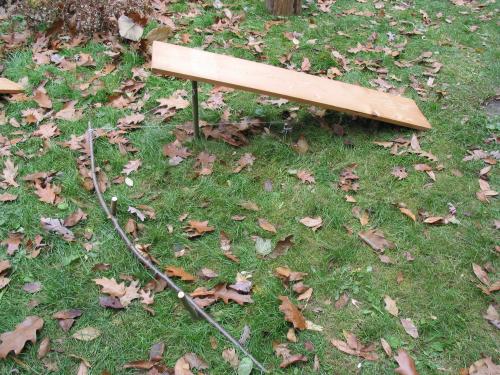
Trap
constructed by Julia Kristof.
|
An overview of the trap.
In this one, the spring is provided by placing the
spring stick between two pegs stuck into the ground. The trigger is
visible under the plank - in this case, it is rather deeply under
the plank (which is the deadfall).
When the trigger is sprung, the spring stick is
released, pulling the vertical stick out, allowing the deadfall to
fall.
|
|
|
|
|
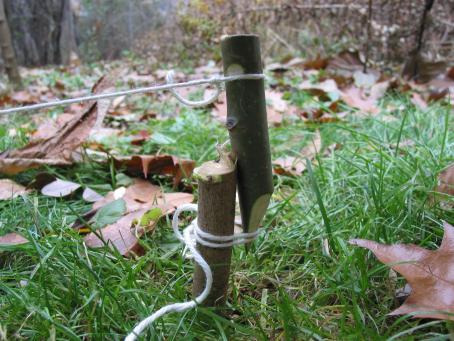
Trigger constructed by Walter Muma
|
Here is a photo of the trigger. The upper stick is being
pulled towards the left by a string tied to the spring stick. It is
being held back by a short string tied to a peg in the ground.
The two faces that meet are left rounded to enhance the
sensitivity of the trigger.
The bait can be placed anywhere on the mechanism, since
even the least little bit of movement will spring the trap.
So, for example, if the bait is placed along the
horizontal string, when it is moved slightly, the upper peg will flip
out away from the lower peg, releasing the spring stick.
|
|
|
|
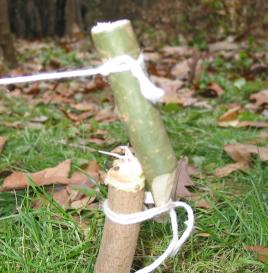
Trigger constructed by Walter Muma |
The sensitivity of the trigger can be adjusted by varying the height
of the upper peg in relation to the top of the lower peg and the
string holding it to the lower peg.
This photo shows a very sensitive trigger layout. The upper peg is
barely being held in place by the lower peg. Only a tiny bit of the
point of the upper peg is being held by the string to the lower peg.
|
|
|
|
|
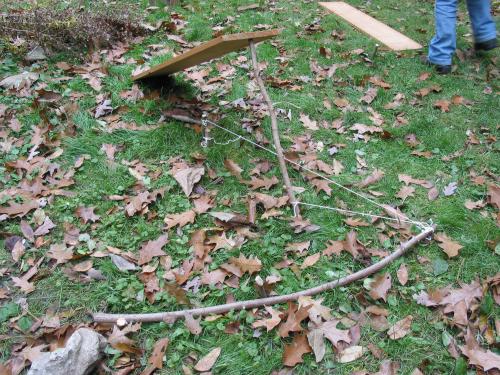
Trap constructed by Walter Muma
|
In the trap shown here, the vertical stick holding up the
deadfall is angled, making it much easier for the spring stick to pull
it away.
Note that you must consider the effect of the peg
sticking up out of the ground under the deadfall (you don't want it to
prevent the deadfall from falling completely).
|
|
|
|
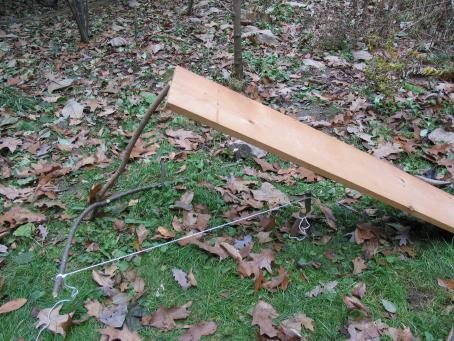
Trap constructed by Walter Muma
|
A variation of this trap.
Here, the spring stick is positioned so it will kick the vertical
stick out of the way. This eliminates one piece of cordage.
Again, the vertical stick should be placed on a smooth stone so it
will move readily when it needs to.
|
|
|
|
Some trigger variations...
|
|
|
|
In this trigger variation, no cordage is needed at all (the string loop
that holds the bottom of the upper peg to the lower peg is eliminated).
Instead, the upper peg is held in place by means of a notch cut into
the lower peg.
It's a little hard to see in the photos...
|
|
|
|
|
|
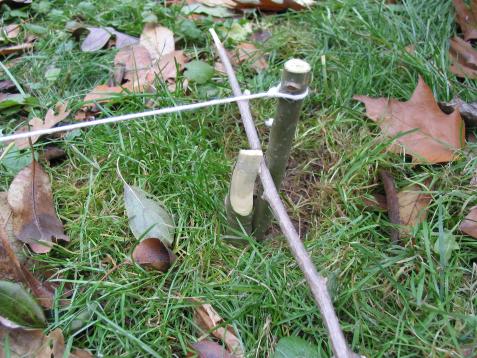
Trigger constructed by
Rob Bicevskis
|
In this trigger variation, a thin horizontal stick can be used to hold
the bait. Any movement of this stick will cause the upper peg to flip
out, thus triggering the trap.
|
|
|
|